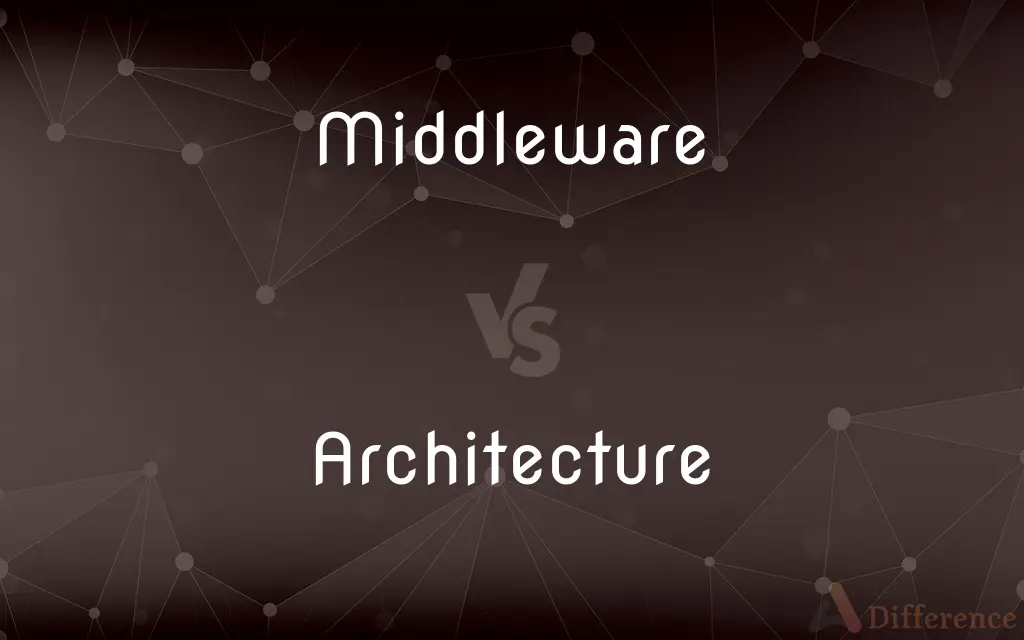Middleware vs. Architecture — What's the Difference?
By Maham Liaqat & Urooj Arif — Updated on March 2, 2024
Middleware refers to software that connects different applications, or services, facilitating communication and data management. Architecture, in a computing context, outlines the structure and organization of a system, including software and hardware.

Difference Between Middleware and Architecture
Table of Contents
ADVERTISEMENT
Key Differences
Middleware serves as a bridge between different software applications, databases, and other tools, enabling them to communicate and share data efficiently. This software layer manages the complexity of disparate systems interacting with each other, offering services such as messaging, authentication, and data management. On the other hand, architecture in the context of computing systems refers to the conceptual model that defines the structure, behavior, and more views of that system. Architecture encompasses the software architecture, which details how software is structured and how components interact, and the hardware architecture, which outlines how physical components are organized and interconnected. The architecture provides a blueprint for both the system's design and its evolution, ensuring that the system meets current requirements and can adapt to future needs.
While middleware focuses on facilitating communication and data exchange between different parts of a system or between different systems, architecture encompasses a broader scope, including the overall design principles, components, and their relationships within the system. Middleware can be considered a component within the broader system architecture, designed to address specific challenges of interoperability and communication in a distributed computing environment.
The relationship between middleware and architecture is complementary. Middleware solutions are often designed with an understanding of the underlying system architecture to ensure they integrate well and support the system's goals. Conversely, an effective architecture may incorporate middleware as a key element to address specific requirements related to communication, data management, and cross-platform interoperability.
Middleware is a software layer that enables communication and data management between different parts of a computing system, while architecture refers to the overarching design and organization of the system. Both are crucial in the development and operation of complex computing environments, but they operate at different levels of abstraction and serve distinct purposes within the broader context of system design and implementation.
Comparison Chart
Definition
Software that facilitates communication and data exchange between different systems or components.
The conceptual model that outlines the structure and organization of a system.
ADVERTISEMENT
Scope
Focused on interoperability and communication between applications.
Encompasses the entire system, including software and hardware components and their interactions.
Purpose
Simplifies development and integration of applications in heterogeneous environments.
Provides a blueprint for system design and evolution, ensuring it meets requirements.
Components
Messaging services, authentication, application services.
Software architecture, hardware architecture, design principles.
Implementation
Acts as a bridge between different software applications or systems.
Guides the development and organization of system components.
Compare with Definitions
Middleware
Middleware enables applications to communicate across different platforms.
Web servers use middleware to handle HTTP requests and responses.
Architecture
Architecture defines the structure and behavior of computing systems.
The microservices architecture organizes an application as a collection of loosely coupled services.
Middleware
Acts as a hidden layer that users and applications interact with indirectly.
Database middleware allows applications to access databases through a standardized API.
Architecture
Encompasses software and hardware components and their relationships.
In a client-server architecture, clients request resources from servers, which provide responses.
Middleware
Essential for building scalable and maintainable distributed systems.
Middleware solutions are used in cloud computing to manage services and resources efficiently.
Architecture
Affects system performance, scalability, and maintainability.
Choosing the right architecture is crucial for the success of large-scale enterprise systems.
Middleware
Simplifies complex distributed systems by managing data flow.
Enterprise Service Bus (ESB) middleware facilitates integration of business applications.
Architecture
Evolves over time to address new requirements and challenges.
Modern architectures often incorporate cloud services and APIs to enhance flexibility and interoperability.
Middleware
Provides common services like authentication and session management.
Middleware in a web application manages user sessions and security.
Architecture
Includes patterns and principles guiding system design.
A layered architecture separates concerns into distinct layers, such as presentation, business logic, and data access.
Middleware
Middleware is a type of computer software that provides services to software applications beyond those available from the operating system. It can be described as "software glue".Middleware makes it easier for software developers to implement communication and input/output, so they can focus on the specific purpose of their application.
Architecture
Architecture (Latin architectura, from the Greek ἀρχιτέκτων arkhitekton "architect", from ἀρχι- "chief" and τέκτων "creator") is both the process and the product of planning, designing, and constructing buildings or other structures. Architectural works, in the material form of buildings, are often perceived as cultural symbols and as works of art.
Middleware
Software that serves as an intermediary between systems software and an application.
Architecture
The art and science of designing and erecting buildings.
Middleware
(computing) Software that functions at an intermediate layer between applications and operating system or database management system, or between client and server.
Architecture
Buildings and other large structures
The low, brick-and-adobe architecture of the Southwest.
Middleware
(computing) Networking software or hardware that is deployed in the middle of, as opposed to serviced by, a packet network to enhance or provide some network function, such as caching, filtering, or firewall functionality.
Architecture
A style and method of design and construction
Byzantine architecture.
Architecture
The structure and design of a system or product.
The architecture of the company's billing system is designed to support its business goals.
Architecture
The art or science of building; especially, the art of building houses, churches, bridges, and other structures, for the purposes of civil life; - often called civil architecture.
Many other architectures besides Gothic.
Architecture
The discipline dealing with the principles of design and construction and ornamentation of fine buildings;
Architecture and eloquence are mixed arts whose end is sometimes beauty and sometimes use
Architecture
The profession of designing buildings and environments with consideration for their esthetic effect
Common Curiosities
What is the role of middleware in a computing system?
Middleware facilitates communication and data exchange between different software applications, systems, or services within a computing system.
How does architecture impact the development of a computing system?
Architecture provides the blueprint for the system's design and organization, impacting its performance, scalability, and ability to meet current and future requirements.
What are some common middleware technologies?
Common middleware technologies include web servers, application servers, message-oriented middleware, and database middleware.
Why is architecture important in system evolution?
A robust architecture allows a system to adapt to new requirements and technologies over time, ensuring its longevity and effectiveness.
How does middleware support distributed computing?
Middleware supports distributed computing by providing a layer that manages communication and data management across different computing environments and platforms.
How do middleware and architecture contribute to system security?
Middleware can provide security services like authentication and encryption, while a secure architecture designs the system to protect against vulnerabilities and threats.
Can middleware exist without a defined system architecture?
While middleware can operate independently, its effectiveness and integration within a system are significantly enhanced by a well-defined system architecture.
How do architects use middleware in system design?
Architects incorporate middleware to address specific communication and interoperability challenges, ensuring seamless interaction between system components.
What considerations are important in choosing middleware for a system?
Important considerations include compatibility with the existing architecture, scalability, performance impact, and the specific communication needs of the application.
Can the architecture of a system change over time?
Yes, the architecture of a system can and often does evolve to incorporate new technologies, address changing requirements, and improve performance and scalability.
Share Your Discovery

Previous Comparison
Pudding vs. Parfait
Next Comparison
Ride vs. RaidAuthor Spotlight
Written by
Maham LiaqatCo-written by
Urooj ArifUrooj is a skilled content writer at Ask Difference, known for her exceptional ability to simplify complex topics into engaging and informative content. With a passion for research and a flair for clear, concise writing, she consistently delivers articles that resonate with our diverse audience.
















































